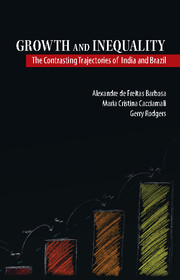Book contents
- Frontmatter
- Contents
- List of Tables
- List of Graphs and Maps
- Preface and Acknowledgements
- List of Abbreviations
- 1 Brazil and India: A Mirror Image of Each Other?
- 2 Approach and Method
- 3 Brazil and India in the Decades before 1980
- 4 India and Brazil from 1980 until 2014
- 5 Key Divides and Cleavages: Ruptures, Continuities, or Adaptation?
- 6 Inequality in Social and Economic Context
- 7 Post-Script
- Bibliography
- Index
7 - Post-Script
Published online by Cambridge University Press: 02 August 2019
- Frontmatter
- Contents
- List of Tables
- List of Graphs and Maps
- Preface and Acknowledgements
- List of Abbreviations
- 1 Brazil and India: A Mirror Image of Each Other?
- 2 Approach and Method
- 3 Brazil and India in the Decades before 1980
- 4 India and Brazil from 1980 until 2014
- 5 Key Divides and Cleavages: Ruptures, Continuities, or Adaptation?
- 6 Inequality in Social and Economic Context
- 7 Post-Script
- Bibliography
- Index
Summary
This is a long-term study, and our original intention was to address the period from the 1940s to 2010 or 2012. But we cannot end a book that compares Brazil and India without considering the divergent paths taken by the two countries since the start of the global financial crisis in 2008, and especially after 2014 – though this is an ongoing story, which has not yet fully worked itself out in either country.
The growth of the global economy remained obstinately low after the crisis. After the initial shock, world GDP fell by close to 2 per cent in 2009, but recovered to a 4.3 per cent growth rate in 2010, and growth in both India and Brazil recovered as well. But the so-called ‘double-dip’ was stronger and longer than expected. World GDP growth dropped to 2.3 per cent in 2013, and after another weak recovery it came down to 2.3 per cent again in 2016. At the same time, the gap between developed and developing countries narrowed, contrary to the idea that there would be some decoupling of their fortunes. So, while in the first stage of the crisis (2008–2011), the growth of the latter countries was three times as fast as the former, in 2015–2016 it was only twice as fast. But there is also great diversity among developing countries, and at present India and Brazil are at the extremes. India is doing the best among large national economies, with growth at around 7 per cent, and Brazil is doing the worst – its GDP fell 3.8 per cent in 2015, and another 3.6 per cent in 2016, in what can be considered its deepest recession in the last century (United Nations, 2015, 2017).
Initially, in both countries, the growth regimes seemed to have survived the global financial crisis unscathed. But as the crisis continued, the social and economic effects were felt in both countries, more sharply in Brazil than in India. It is therefore paradoxical that in the elections of 2014, the government in India fell while that in Brazil just survived. But this respite in Brazil was temporary, for the president was impeached and the PT removed from power in 2016, in what has been described as an ‘institutional coup’.
Information
- Type
- Chapter
- Information
- Growth and InequalityThe Contrasting Trajectories of India and Brazil, pp. 307 - 316Publisher: Cambridge University PressPrint publication year: 2017
